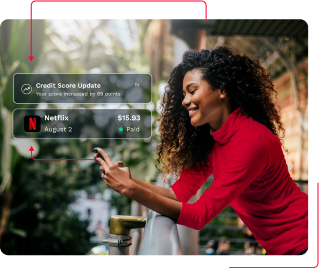
2023 is here and it’s OUT with the old, IN with the new! That includes…the old budget that was NOT working for you.
Here’s the thing about budgeting…it doesn’t have to be boring or even stressful. Put on some upbeat music, grab a refreshing beverage, and let’s dig in!
Just like our first goal-setting workout, this one will have three stages: stretching your mind, warming up your skills, and exercising your new financial muscles.
If budgeting makes you uncomfortable, we’ll confirm: YOU ARE NOT ALONE. Budgeting is scary for a lot of people. Here are some of the reasons you might be avoiding a budget:
Yep, all this stuff is real. But here’s why you should budget ANYWAY: understanding your income and expenses is the key to making more informed decisions and building a strong, anxiety-free financial future.
Plus, we’ll give you the tools you need to reduce household expenses AND make some suggestions to increase your household income.
Simply put, budgeting is creating a plan for how you’ll spend (and save) your money. It involves tracking your monthly income and expenses, and strategizing how you’ll pay for the things you want and need.
To do this, you’ll need to understand some key components: your gross income, your net income, your fixed expenses, and your variable expenses.
“Gross income” is your total compensation before taxes and other paycheck deductions. If you’re a salaried employee, divide your annual salary by twelve to calculate gross income. (Ex: $60,000/year ÷ 12 = $5,000).
If you’re paid by the hour, multiply your hourly wage by the number of hours you work each week, and multiply the total by 52. (Ex: $15/hr x 40 hours/week x 52 = $31,200/year) Divide by twelve to find your monthly gross income.
Net income is another term for “take-home pay.” It includes all the money from your paycheck and other sources of income (like side-hustles, child support, etc) that you have access to after your taxes are paid.
To find your net income, calculate how much money gets deducted from your paycheck each month and subtract this from your monthly gross income. You can typically find this information on your pay stub. Ask your HR or payroll department if you have trouble finding the details you need.
Once you’ve identified your monthly net income, it’s time to take a look at your expenses. It can be scary to crunch the numbers, but it’s an important part of financial wellness. Calculate your fixed and variable monthly expenses to get a clear picture of how you spend money.
Fixed expenses stay the same each month. For most people, this includes rent or mortgage payments, phone bills, installment loans, and insurance premiums. Fixed expenses are predictable, which makes them easy to factor into a budget.
Variable expenses change from month-to-month. They include things like gasoline purchases, credit card payments, home maintenance costs, and leisure spending. Since variable expenses are less predictable, it’s smart to estimate these expenses on the high-end as you budget.
Once you have a good grasp of these budget components, you’re ready for the next step: creating and optimizing your budget.
There’s no “one size fits all” budgeting strategy. Check out the options below and get started with the method that sounds best to you:
The envelope budget system is another time-tested method. It’s simple: label envelopes with specific monthly expenses – like loan payments, rent, or membership fees – and split your cash into each on payday.
You can also take this system digital with envelope budgeting apps like Qube and Goodbudget.
Tip: Use your StellarFi dashboard to track your expenses and make sure all your bills are paid on time.
The basic rule of the 50-30-20 budget is to split up your after-tax income and spend: 50% on needs, 30% on wants, and put away 20% for saving. Of course, with rising costs of living and inflation rates, you may have to tweak the numbers based on your reality.
Do you prefer a more hands-on approach to your finances? Grab a notepad and a pencil. List your fixed and variable expenses, and look for areas to cut back on your spending.
Zero-based budgeting earmarks every dollar you make – whether for bills, debt payments, leisure spending, or your savings account. The goal is that your income minus your expenditures equals zero by the end of the month.
You’re on the home stretch now! Here’s the fun part of this challenge: make more room in your budget by bringing in some extra cash.
Gig work is a common way to earn extra income on your own terms. Food delivery, driving for Uber or Lyft, and other gigs can enable you to make money during weekends or evenings.
Luckily, you don’t always need a second job or even a pay raise to increase your income.
StellarFi is partnered with KashKick to help more people earn more money in their downtime by completing simple tasks on your phone or even by playing games and testing apps! Check it out here.
Most suggestions to decrease your expenses are based on decreasing your variable expenses.
Some of the common ways to do this are to eat out less, to curb your impulse-shopping habits (especially online), and to use more coupons and discounts on food and other goods.
As a StellarFi member, you can actually cut back on your fixed expenses too! Here’s how it works:
Like anything in life, budgeting is easier when you take it one step at a time and trust the process. And as always, you have StellarFi on your side 💪 Link more bills to build credit faster AND track your expenses more accurately.
Learn more about budgeting in our blog.

StellarFi (StellarFinance, Inc.) and its affiliates do not provide financial, tax, legal, or accounting advice. This material has been prepared for informational purposes only, and is not intended to provide, and should not be relied on for, tax, legal, or accounting advice. You should consult your own financial, tax, legal, and accounting advisors before engaging in any transaction. StellarFi receives a referral fee from the partners mentioned in this article.

With StellarFi, your bills are paid on time and reported to Experian® and Equifax®.